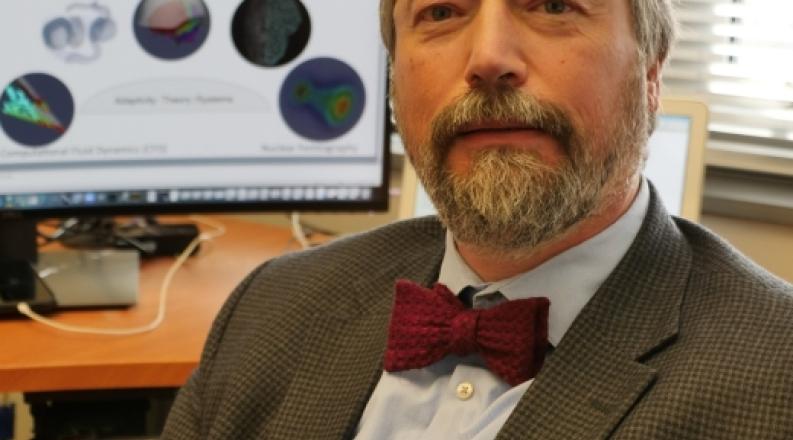Nikos Chrisochoides, Richard T. Cheng Endowed Professor and Eminent Scholar in ODU’s Department of Computer Science, and his Center for Real-Time Computing (CRTC) group worked with Gagik Gavalian, staff scientist at Jefferson Lab, to apply machine learning (a type of artificial intelligence) to nuclear physics data analysis.
By Gail Dodge and Tiffany Whitfield
A collaboration between nuclear physicists and computer scientists at Old Dominion University and the Thomas Jefferson National Accelerator Facility (Jefferson Lab) has dramatically increased the information that can be extracted from experiments at the lab, potentially worth millions of dollars per year.
Nikos Chrisochoides, Richard T. Cheng Endowed Professor and Eminent Scholar in ODU's Department of Computer Science, and his Center for Real-Time Computing (CRTC) group worked with Gagik Gavalian, staff scientist at Jefferson Lab, to apply machine learning (a type of artificial intelligence) to nuclear physics data analysis.
At Jefferson Lab, electrons are accelerated to the speed of light, forming a powerful high-energy beam to probe the inside of the atomic nucleus. The nucleus is composed of protons and neutrons, each of which is further made up of quarks and gluons. When an electron collides with one of these subatomic particles (called an "event"), several particles are usually produced, including particles created from the energy in that event. These ejected particles help us understand the substructure of protons and neutrons, where many scientific questions remain unsolved.
The application of machine learning by ODU scientists to identify particle tracks at Jefferson Lab involved using brand-new techniques to solve what previously was not possible.
As Lawrence Weinstein, ODU Eminent Scholar and professor of physics and past chair of the Jefferson Lab Users Organization, wrote, "By improving particle trajectory reconstruction, this project increased the number of reconstructed complicated nuclear collisions by 35%. This allows us to get 35% more physics from the same data, which would otherwise cost about $5 million per year."
The challenge for physicists analyzing these electron-nucleus collisions is to identify all the particles created, including measuring their momentum. However, measuring these sub-atomic particles is difficult. Jefferson Lab uses house-sized "spectrometers" to reconstruct the energies, momenta and identities of these particles from the tiny traces of energy left behind as they traverse the detectors in the spectrometers.
Unfortunately, in addition to the tracks of the particles, there is also a lot of noise in the detectors, due to unwanted particles and radiation. Reconstructing a particle track requires identifying all the detector "hits" caused by that particle, while disregarding the hits caused by noise. A valid track typically leaves more than 100 hits in the spectrometer. But there may be an equal or greater number of stray signals among the hundreds of thousands of detector channels.
ODU graduate student Polykarpos Thomadakis and the rest of the CRTC team developed deep learning models that are used to "de-noise" the highly noisy data produced by running the Jefferson Lab electron beam and the CLAS12 spectrometer at high rates. After utilizing the de-noising method they developed, particle tracking efficiency increased by up to 80% compared with the conventional algorithm.
"This work suggests that new tracking algorithms with Artificial Intelligence (AI) open the possibility of conducting experiments at higher luminosity, collecting larger data samples for physics reactions in a shorter time," Chrisochoides said.
Gavalian explained the impact: "The expertise provided by the CRTC group was instrumental in developing novel machine learning models to assist conventional tracking algorithms. The improvements achieved in track reconstruction efficiency increase the statistical precision of measured observables for existing experimental data, as well as pave the road for conducting experiments with higher luminosity collecting significantly more data."
Chrisochoides and his CRTC team have developed the real-time computing techniques over time at ODU and have worked on this project for three years.
"The success of this project highlights the benefits of interdisciplinary research as well as data science techniques, which can be used to enable breakthroughs in other areas of science," said Gail Dodge, dean of ODU's College of Sciences. "It is not easy for scientists in different fields to learn each other's language and get past the initial hurdles to create an effective collaboration. Dr. Chrisochoides, Dr. Gavalian and the team of CRTC students turned a small financial investment and a lot of hard work into an incredible achievement."
Chrisochoides said, "When it is compared to operational cost using software based on traditional data analytics methods and without compromising the accuracy of the results, it doubles the number of physics statistics accumulated per day, allowing experiments to run in half the time."
What's next for the CRTC team at ODU? Chrisochoides plans to use quantum computing in particle tracking and brain surgery. Stay tuned.



